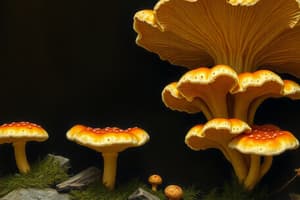Podcast
Questions and Answers
What is the primary method of reproduction in yeast?
What is the primary method of reproduction in yeast?
- Fragmentation
- Spores
- Budding (correct)
- Binary fission
Zygospores are produced through asexual reproduction.
Zygospores are produced through asexual reproduction.
False (B)
What is the role of zymase in yeast metabolism?
What is the role of zymase in yeast metabolism?
It speeds up the anaerobic respiration of sugars.
The formula for anaerobic respiration in yeast is C6H12O6 = 2 C2H5OH + 2 ______.
The formula for anaerobic respiration in yeast is C6H12O6 = 2 C2H5OH + 2 ______.
Match the following types of yeast with their characteristics:
Match the following types of yeast with their characteristics:
What happens to a yeast cell after budding occurs?
What happens to a yeast cell after budding occurs?
Yeast can reproduce by forming zygospores.
Yeast can reproduce by forming zygospores.
Which of the following structures in Rhizopus is responsible for anchoring the fungus to its food source?
Which of the following structures in Rhizopus is responsible for anchoring the fungus to its food source?
All fungi are saprophytic in nature.
All fungi are saprophytic in nature.
What process do fungi primarily use to obtain nourishment?
What process do fungi primarily use to obtain nourishment?
The collection of hyphae in fungi is called _____
The collection of hyphae in fungi is called _____
Match the following structures of the fungus Rhizopus with their functions:
Match the following structures of the fungus Rhizopus with their functions:
Which structure is responsible for producing haploid spores in Rhizopus?
Which structure is responsible for producing haploid spores in Rhizopus?
Asexual reproduction in Rhizopus involves the fusion of gametes.
Asexual reproduction in Rhizopus involves the fusion of gametes.
What happens to the wall of the sporangium when it matures?
What happens to the wall of the sporangium when it matures?
During asexual reproduction, the tip of the sporangiophore swells to form a __________.
During asexual reproduction, the tip of the sporangiophore swells to form a __________.
What role does the apophysis play in asexual reproduction?
What role does the apophysis play in asexual reproduction?
Spores produced during asexual reproduction are only capable of being transported by water.
Spores produced during asexual reproduction are only capable of being transported by water.
In sexual reproduction, what type of zygotes are formed when two nuclei fuse?
In sexual reproduction, what type of zygotes are formed when two nuclei fuse?
The __________ are resistant structures formed during sexual reproduction in Rhizopus.
The __________ are resistant structures formed during sexual reproduction in Rhizopus.
Match the following terms with their descriptions:
Match the following terms with their descriptions:
What triggers the germination of spores in Rhizopus?
What triggers the germination of spores in Rhizopus?
Flashcards are hidden until you start studying
Study Notes
Zygospore Characteristics
- Zygospore disperses and germinates under suitable conditions.
- The zygote undergoes meiosis, leading to the growth of a haploid sporangiophore.
- A sporangium forms at the top of the sporangiophore, initiating asexual reproduction.
Yeast (Saccharomyces cerevisiae)
- Common yeast used in baking, known as baker's yeast.
- Other yeasts include Candida albicans, which can cause infections.
- Baker's yeast obtains nutrients from sugar-rich environments like rotting fruit.
Yeast Respiration
- Yeast performs anaerobic respiration of sugars to gain energy.
- The fermentation equation is C6H12O6 → 2 C2H5OH + 2 CO2, producing ethanol and carbon dioxide.
- Zymase is the enzyme that accelerates the fermentation process.
Yeast Reproduction
- Budding is the main asexual reproduction method in yeast.
- A bud forms at the cell's edge, dividing nucleus and vacuole between parent and bud.
- Pseudomycelium occurs when buds grow on multiple sides, forming branched structures.
Asexual Reproduction in Rhizopus
- Asexual reproduction is predominant, featuring sporangiophore tips swelling to form columella.
- Columella is separated from sporangiophore by an apophysis and produces haploid spores by mitosis.
- Mature sporangium turns black, dries out, and bursts, spreading spores via wind to suitable substrates.
Sexual Reproduction in Rhizopus
- Occurs through hyphae of different strains (designated plus and minus).
- Progametangia swell and meet, forming gametangia upon separation from stalks.
- Fusion of nuclei from gametangia produces diploid zygotes, which develop thick walls to form zygospores.
Fungi Overview
- Fungi are eukaryotic organisms with membrane-bound nuclei and organelles like mitochondria.
- They can be saprophytic, breaking down organic material, or parasitic, causing harm to hosts.
- Some fungi are edible, while others, like Amanita phalloides, are highly toxic.
Fungal Structure and Nutrition
- Fungi consist of hyphae, which are thin threads permeating their substrate known as mycelium.
- Nutritional process involves extracellular digestion through three steps:
- Excretion of digestive enzymes by hyphae.
- Breakdown of surrounding dead plant materials.
- Absorption of digested products for nutrition.
Rhizopus Specifics
- Black bread mould, commonly found on stale bread and rotting fruit, is haploid (n).
- Stolon: Aerial hyphae that grow horizontally and eventually turn downwards to form rhizoids.
- Rhizoids penetrate the food source, securing the fungus and releasing digestive enzymes for nutrient absorption.
- Sporangiophore: Unbranched hyphae that emerge from rhizoid tufts.
Studying That Suits You
Use AI to generate personalized quizzes and flashcards to suit your learning preferences.



